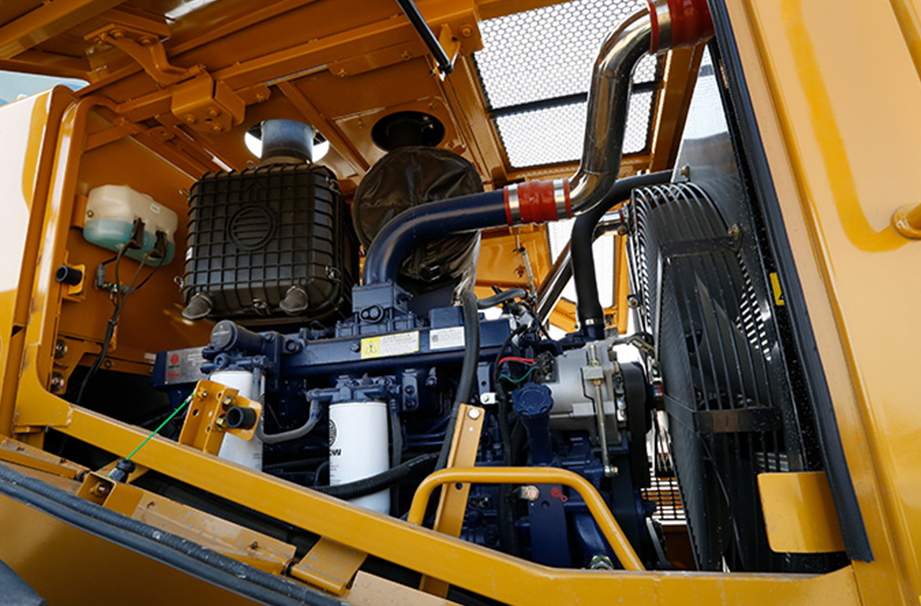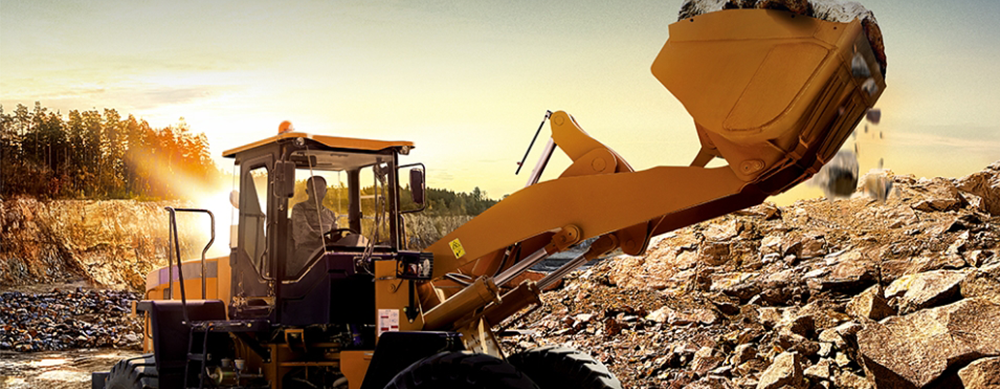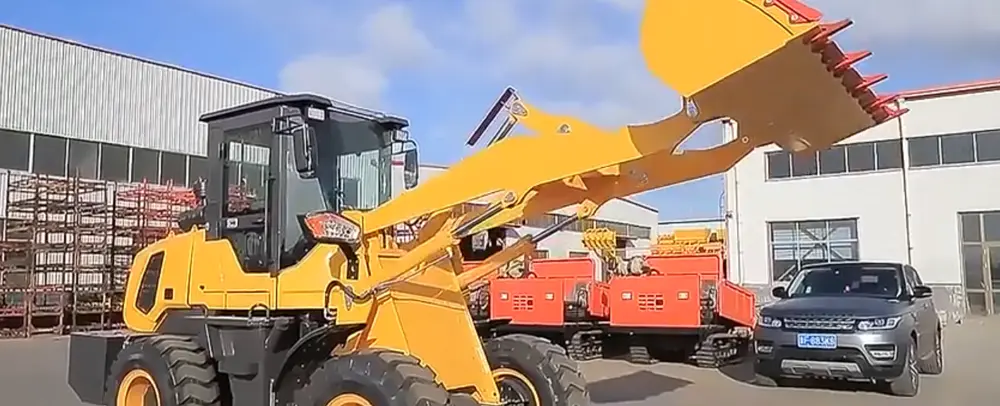Wheel loaders are essential heavy equipment in construction and material handling. They feature a robust, articulated chassis that provides excellent maneuverability, allowing them to turn tightly in confined spaces. The large front bucket, mounted on strong lift arms, can scoop up significant volumes of materials like soil, gravel, and sand. Powered by a potent diesel engine, they offer high productivity, with quick loading cycles. The operator's cab is designed for comfort, equipped with ergonomic controls and good visibility. Whether it's loading trucks at a quarry, stockpiling materials on a construction site, or handling bulk goods in a warehouse, wheel loaders play a crucial role.
| Pictures |
|
|
|
|
|  |
| Basic parameters | ||||||
| Model | 966L | 966GC | 972L | 980L | CAT982 | CAT 988 |
| Rated load capacity (kg) | 6600 | 6600 | 7200 | 8000 | 8000 | 51062 |
| Total operating weight (kg) | 23220 | 21577 | 24890 | 30090 | 35510 | 14500 |
| Bucket capacity (m³) | 3.20~7.40 | 3.8-7.1 | 2.8-14 | 4.2-12.2 | 4.8-17.2 | 4.7-13 |
| Maximum digging force (lifting force) (kN) | 173 | 196 | 224 | |||
| Travel mode | Tire-type | Tire-type | Tire-type | Tire-type | Tire-type | |
| Application | General purpose | General purpose | General purpose | General purpose | General purpose | |
| Tonnage range | 5-8 tons | 5-8 tons | 5-8 tons | Over 8 tons | 5-8 tons | |
| Power Type | Fuel | Fuel | Fuel | Fuel | Fuel | |
| Engine (fuel) | ||||||
| Model | C9.3 ACERT | Cat C9.3B | C9.3 ACERT | C13 ACERT | Cat C13 | Cat C18 |
| Rated power/speed (kW/r/min) | 207/1700 | 239@2200 | 253/1600 | 278.0/1800 | 301/1700 | 439/1700 |
| Maximum torque/speed (N·m/r/min) | 1507/1000 | 1779@1200 | 1632/1100 | 2040/1000 | 3023/1500 | |
| Total Displacement (L) | 9.3 | 9.3 | 9.3 | 12.5 | 449 | 18.1 |
| Engine Brands | Caterpillar | Caterpillar | Caterpillar | Caterpillar | Caterpillar | Caterpillar |
| Emission standard | Euro 4 | Euro 4 | Euro 4 | Euro 4 | Euro 4 | Euro 4 |
| Hydraulic system | ||||||
| Flow rate (at rated speed) (L/min) | 320 | 580 | ||||
| Rated working pressure (Mpa) | 27.9 | 32.8 | ||||
| Travel speed 1st gear (forward/reverse) (km/h) | 6.5/7.1 | 6.4/7.0 | 6.9/7.8 | 6.9/7.8 | 6.5/7.5 | |
| Travel speed 2nd gear (forward/reverse) (km/h) | 13.1/14.4 | 12.1/13.2 | 13.1/15.0 | 13.3/15.2 | 11.6/13.3 | |
| Travel speed 3rd gear (forward/reverse) (km/h) | 23.5/25.9 | 21.0/23.0 | 23.2/26.5 | 23.5/26.9 | 20.4/23.2 | |
| Travel speed 4 speeds (forward/reverse) (km/h) | 39.5/39.5 | 34.8/36.9 | 39.5/39.5 | 39.5/39.5 | 34.7 | |
| Fuel volume | ||||||
| Fuel tank capacity (L) | 303 | 320 | 303 | 426 | 426 | 712 |
| Hydraulic System (L) | 125 | 120 | 125 | 153 | 153 | 240 |
| Engine oil (L) | 25 | |||||
| Cooling System (L) | 71.6 | 53 | 71.6 | 45 | 52 | 120 |
| Transmission System (L) | 58.5 | 55 | 58.5 | 77 | 120 | |
| Dimension | ||||||
| Overall length (mm) | 7362 | 9315 | 9627 | |||
| Overall width (mm) | 2230 | 2230 | 2440 | |||
| Overall height (mm) | 3859 | 2804 | 3859 | 4112 | ||
| Minimum Ground Clearance (mm) | 434 | 455 | 434 | 453 | ||
| Bucket width (mm) | ||||||
| Wheelbase (mm) | 3550 | 3550 | 3550 | 3800 | ||
| Unloading height - unloading angle of 45° (mm) | 2991 | 3154 | 3273 | |||
| Unloading distance - unloading angle of 45° (mm) | 1353 | 1357 | 1481 | |||
| Minimum turning radius (at center of outside wheel) (mm) | 6761 | 6761 | 14806 |

1. Bucket: This is the workhorse of the wheel loader, attached to the front end. It comes in various sizes and shapes for different materials and tasks.
2. Lift Arms: These are connected to the bucket and the front of the frame. They are powered by hydraulic cylinders to raise and lower the bucket, providing the necessary lifting force for loading and unloading materials.
3. Hydraulic System: Comprises pumps, cylinders, hoses, and valves. The hydraulic pump generates pressure to move the fluid, which powers the lift arms and other hydraulic functions like bucket tilt and steering.
4. Engine: Usually a diesel engine, it is the power source that drives the hydraulic system and provides the energy for the loader to move and operate.
5. Transmission: Transfers power from the engine to the wheels. It allows the wheel loader to move forward, backward, and change speeds.
6. Axles and Wheels: The axles connect the wheels to the frame. Front axles are often steerable for better maneuverability.
7. Cab: The operator's compartment is designed for comfort and functionality. It has controls for operating the loader, a seat with good ergonomics, and large windows for excellent visibility of the work area.
8. Counterweight: Located at the rear of the loader, the counterweight balances the weight of the front bucket and the load being carried.

1. Bucket Capacity: Determine the volume of material you need to move in a single scoop. Bucket capacities can range widely, from small loaders with a capacity of around 1-2 cubic yards to large industrial loaders with capacities exceeding 10 cubic yards.
2. Cycle Time: The time it takes to complete a loading cycle (lift, carry, dump, and return) is crucial for productivity.
3. Terrain Conditions: Consider the type of ground on which the loader will operate. If it's a rough construction site with uneven surfaces, you'll need a loader with good ground clearance and durable tires or tracks.
4. Space Constraints: In confined work areas like warehouses or small construction yards, a compact wheel loader with a small turning radius is essential.
5. Engine Power: A powerful engine is necessary for handling heavy loads and maintaining efficient operation. The engine's horsepower and torque output should match the demands of your work.
6. Lifting Capacity: Check the maximum weight the loader can lift and carry at different heights and reaches. This is vital for ensuring it can handle the materials you work with.
7. Transmission Type: There are different transmission options, including manual, automatic, and hydrostatic transmissions.
8. Operator Comfort: A well - designed cab with an ergonomic seat, good climate control, and low noise and vibration levels reduces operator fatigue.

Wheel loaders are renowned for their large front-mounted buckets that can handle substantial volumes of materials. The bucket sizes vary, allowing for different load capacities depending on the model and intended use.
These machines have an articulated chassis design that gives them exceptional maneuverability. The ability to pivot in the middle allows for a tight turning radius, which is crucial when operating in confined spaces like construction sites, warehouses, or loading docks.
Wheel loaders are equipped with a robust diesel engine that provides the power required for both movement and loading operations.
One of the key features of wheel loaders is their compatibility with a wide range of attachments. In addition to the standard bucket, they can be fitted with other useful tools such as pallet forks for handling pallets and shipping containers, snow blades for snow removal, and brush cutters for land-clearing.
The operator's cab in a wheel loader is designed with comfort and functionality in mind. It features an ergonomic seat to reduce operator fatigue during long-working hours.
Wheel loaders have a solid frame and body structure made of high-strength materials to withstand the rigors of heavy-duty work. The bucket, lift arms, and other components are also built to be durable and resistant to wear and tear.

